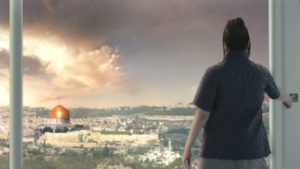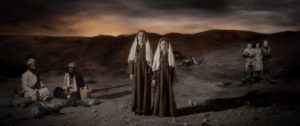Larissa Sansour’s three short films that screened at the MFA this Monday – A Space Exodus, Nation Estate, and In the Future, They Ate From the Finest Porcelain – showcase an intersection between politics and science fiction, within which lurks the emotional tension of the Israel-Palestine conflict.
In A Space Exodus, Sansour conceptualizes Kubrick’s 2001: A Space Odyssey through the eyes of a Palestinian in space, a feat which has never been achieved before. The replacement of ‘odyssey’ with ‘exodus’ conveys a different sense of movement on the level of society; one that is, perhaps, less of an adventure and more of a mandate. Roughly five and a half minutes long, A Space Exodus doesn’t have a storyline so much as it has an elaborately layered vision of the future; its one and only character, portrayed by Sansour herself, floats at ease through space, gazing at the earth in the distance after firmly planting the Palestinian flag in the moon’s dry soil. The film’s music is another layered concoction, blending Middle Eastern musical elements with the kind of drawn out, echoing sounds one might expect to hear in space, where emptiness abounds. In the end the film’s astronaut is heard calling out to Jerusalem, trying to make contact, with no response.
Nation Estate builds a much grander vision of the future than A Space Exodus, while still staying centered on an individual character (again played by Sansour). Compared to the vast black expanse of space in the first film, dotted with stars in the distance, Nation Estate is blinding in its brightness, offset by the calming dark blue of Sansour’s woven blouse and its patterning in the shape of diamonds, which the camera closes in on several times. Its spaces are also quite vast; she’s first seen climbing a series of escalators and entering a gigantic white hall which we see from high up above. Ant-like figures walk in various directions to carry on their days.
A suitcase trails behind her as she presses the button for an elevator and waits for it to arrive. While waiting a wide shot reveals an enormous sign on the wall, on which the building’s floors are printed; she peers at the list, perhaps to remind herself of what number she’ll need to choose when she steps in the elevator. On the list are locations like the Dead Sea – negative three floors down – and cities like Jerusalem, Gaza City, and Bethlehem, among many other places. There are departmental locations like ‘Aid and Development,’ ‘Government HQ,’ ‘Hospital’ and ‘Wildlife Reserve.’ The building stands in as the whole of Palestine, stretched out vertically.
Sansour looks to her left and examines an ad: “Nation Estate: Living the High Life” it reads, with a tree looming in the foreground. Several buildings are clustered in the background, and we can assume that the tallest of them is the one in which she stands.
As the elevator climbs above Jerusalem (two other people in the elevator get off here) and past other cities, Sansour exits on the level of Bethlehem and walks steadily across a marble floor which is stylized to have an antique look – but which is clearly new and polished. She’s surrounded by ornately decorated walls whose facades protrude to reveal geometrical complexity, and whose entrances are dome-shaped, conjuring images of typical middle eastern architecture. Finding her apartment, she enters, heats a pre-packaged meals – a typical Palestinian dish of some kind – and waters a tree that stands near her wall-sized window.
The tree’s roots burst through the white tiled floor, and overall it is the most alive out of anything we’ve seen so far – even the people, who haven’t said anything and seem to be going through the motions, unaffected or perhaps just used to what they’re doing and seeing.
The final sequences of the film reveal that this woman is carrying a child – something I didn’t notice before and which I suspect was meant to be hidden – and that there is, after all, a world outside of this sky-high, colossal structure’s sterility and lifelessness that the Palestinian people seem to call home. But what’s left unclear is if this is home to all Palestinians, or if these are perks reserved for an elite class.
What stood out for me in Nation Estate were subtle hints at potentially severe effects of climate change, or perhaps the hyper-commercialization of nature’s limited resources: in the elevator, an ad boasts the quality of water supplied from distant Norwegian fjords. Indeed, it occurs to me that the sci-fi of our age – an age threatened with the imminent disappearance of basic resources – might be at least partly defined or shaped, in a narrative sense, by catastrophic events in climate change and their effects on the human populace.
Like A Space Exodus, Nation Estate‘s emphasis isn’t on storytelling, but rather on world-mapping. An “arabesque electronica soundtrack,” as the film’s official description writes, permeates throughout the unfolding of this hyper-technological, deafeningly white world, providing a certain suspense that’s realized when the final shot reveals the full breadth of this building, its capacity seemingly limitless.
In the Future, They Ate From the Finest Porcelain trades the other films’ focus on establishing a geopolitical setting for the creation of a highly cerebral narrative conjuring the innermost workings of the subconscious – not that the former is entirely absent, but it is perhaps less clear where we are. Most of the narrative comes through a conversation between the protagonist, a resistance fighter beset by traumas incurred in her childhood – when her 9-year-old sister was killed – and a psychiatrist who presses her to divulge personal and political beliefs. The deceased sister comes to symbolize the children and other innocent civilians who get caught up in the violence of political conflict; she appears in the protagonist’s recurring dreams and in various sequences in the film, haunting both her adult sister and the audience.
Although, as this resistance fighter observes, the careless power of rulers in this world enables them to “unsee” the violence that results from their decisions, in her sister “they saw everyone and everything.”
The dark skylines of In the Future which sometimes burn with crimson reds and oranges, the last remnants of sunset, contrast heavily with the blinding light of Nation Estate. The resistance fighter wages her battles in the shadows as part of a “narrative resistance” group, who have developed an elaborate plan to establish themselves as the rightful inheritors to this land by planting porcelain ceramics in the soil and artificially dating them to appear hundreds, perhaps even thousands of years old. By associating themselves with these unearthed cultural artifacts, the power of myth, and its ability not just to “create fact” but also to “generate identification,” will hand them the keys to the kingdom by virtue of historical entitlement. Such a claim to history, and to land, immediately becomes a parallel to the current situation in Israel-Palestine.
The protagonist’s illicit activities have been branded as a form of “narrative terrorism,” a threat to the state as it exists in this reality; specific details about this state are never divulged. Its exact nature being hidden, like the protagonist’s pregnancy in Nation Estate, adds to the film’s mysterious undertones, both temporally and spatially.
The psychiatrist serves as a device to bring out the resistance fighter’s thoughts, ideas, and feelings, noted Leila Sansour, the sister of the filmmaker (and director of Open Bethlehem, which screened the night before), in response to an audience question in the Q&A afterwards. Though Leila couldn’t divulge exact information on particular decisions and intentions of her sister in making these films, she provided a lens through which we came to understand Larissa’s work better, and to see its context a bit more clearly. Explaining that Larissa grew up during the First Intifada, In the Future’s protagonist seems to have a deeply personal character.
In the Future has an eerily slow pace to it. The resistance fighter walks through the desert in the dark, with a flashlight strapped to her head, taking time to scope the ground (perhaps for good places to plant porcelain). Slow close-ups, against black backdrops, reveal chilling portraits not only of the protagonist’s face and the fear that seems to lurk behind her eyes, but also of two young girls wearing matching dresses and braids, holding hands. One breaks their grip, turns away and walks off-screen; she is the sister who was killed. Later on, she appears alone, serving as a motif, a visual representation, of the resistance fighter’s trauma – a trauma that has inspired her radical activity against the state.
The film’s essayistic tone is also paired with sweeping scenes of a biblical nature, generated through a combination of CGI and live motion. These iconic images were described by Leila Sansour as ultimately of a cultural nature, evoking the link between mythology, politics and identity. While the films have a “religious momentum,” their use of iconography doesn’t aim to appear allegorical – Larissa avoids allegory – but, rather, to establish a connection between folktales and the cultural imagery that comes to represent them through time.
An especially powerful point made by Leila Sansour – indeed, my ‘takeaway’ for the night after seeing these films, and a message that has stayed with me – is the use of science fiction as a register or language, and crucially an international one, to engage with temporality, encourage commentary, and challenge beliefs. While I’m no expert on science fiction film or the history of the genre in general, the textural and thematically layered quality of Larissa Sansour’s work resonates with me on both emotional and wider social and political levels because of its use of such a language. She shows how it is possible for artists to engage with issues and conflicts at the level of both individual and society in a way that furthers a better collective understanding, without being insensitive, or revealing too much, or encouraging complacency. A greater truth is revealed about the complexity of humanity and its struggle for survival; such a conclusion serves as a core tenet on which successful science fiction is built.
A Space Exodus
2009
dir. Larissa Sansour 5.5 min.
Nation Estate
2012
dir. Larissa Sansour
9 min.
In the Future, They Ate from the Finest Porcelain
2015
dir. Larissa Sansour
29.5 min.
Screened Sunday, 10/30 @MFA Boston
Part of the 10th Annual Boston Palestine Film Festival








